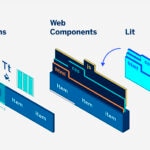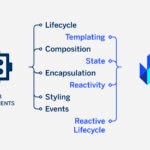How to optimise the process for creating web components
Web components are a set of features that allow the creation of reusable elements in web pages and applications. When developing, you get fast and efficient delivery of consistent, high-quality user interfaces for all platforms. But creating web components can be tedious and repetitive, so how can we improve it? The use of some tools or libraries such as Lit makes it possible to speed up and optimise the process.

In the field of development, web components offer a powerful tool for creating design systems that maximise flexibility in the use of technology because they can be adapted to a wide range of projects.
However, building web components from scratch can become redundant and it is common to replicate patterns and logic in different parts of the code, as the creator of Shoelace explains in this post.
Lit and its characteristics
Lit is an open source library from Google that helps developers expand the potential of web components, offering a unique combination of reactivity, state management and highly efficient and lightweight rendering, which facilitates abstractions while reducing unnecessary code repetition.

The main advantages of Lit are basically the following: Simplification and agility of the development process.

It achieves this through the following elements:
Development Experience (DX): Lit speeds up the development process by simplifying repetitive tasks, thus allowing the developer to focus all their efforts on the implementation that the component must deliver. Since they are part of the web standards, developer tools are integrated into and evolve with the browsers.
Web Standards = Interoperability: The components we develop with Lit are web components, no more and no less, there is no compilation step, they are not linked to any specific framework, their use is direct in the web browser. This ensures interoperability and current and future compatibility.
Reactivity: The reactive properties enable us to easily model both the public and private API of our web components, because these properties give us the inputs we need to manage the different states of the component. This ensures that the component and its attributes respond in accordance with the inputs received.
State management & Life cycle: When the reactive properties receive a new input, the Lit life cycle is activated to render the necessary changes. This allows us to manage the state and handle any side effects.
Rendering: We arrive at the key point of our web components, which is the creation and management of DOM nodes, responsible for updating the user interface and therefore crucial for interaction. It is precisely in this critical process that directly affects performance and, therefore, the user experience that Lit really shines.
Leveraging the power of the "template literals", a native feature of JavaScript, Lit can accurately distinguish between static and dynamic content. In this way, it allows for agile and efficient manipulation of the DOM, taking advantage of the native capabilities of web browsers and optimising the process of updating the user interface.
Prepared for the future: Of all the points we have seen, perhaps the most important one is to understand that Lit is built on a solid and secure foundation, i.e. the web standards, which guarantees its interoperability and flexibility over the current dependence on frameworks.
An example of this commitment to the future is "The Interop Project", a collaborative initiative between the main manufacturers of web browsers that aims to ensure that browsers work in a coherent way to improve web technologies in general, including, of course, web components.
In short, Lit is a tool that simplifies and optimises the development of web components. Its focus on web standards, robust reactivity, efficient state management, and optimised rendering make it an attractive option for creating dynamic, scalable, and flexible web interfaces.
Are you up for trying Lit? Lit Playground